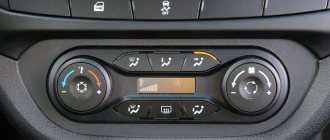Despite the fact that many people prefer to purchase foreign-made cars, currently the domestic automobile industry has begun to produce quite successful car models. If you want to get an answer to the question of which is better, Lada Granta or Lada Vesta, you will need to study in sufficient detail each component of these two Russian cars. People buy these two options, first of all, for the reason that their cost is not as high as that of their foreign counterparts, and the build quality and technical characteristics are much better than the company’s previous cars. These cars have almost the same number of trim levels. However, in order to understand which car is better, you need to make a detailed comparison.
Vesta
Despite the fact that Vesta is gaining fairly confident sales momentum not only in the domestic but also foreign markets, Granta is also not going to give up its positions. Granta continues to be popular for the reason that its cost is much less than that of its competitor. And from a visual point of view, the car looks pretty good, especially considering the recent modifications. Overall, both cars deserve the attention of potential buyers.
Now we need to make a detailed comparison of these cars. From a visual point of view, as well as in terms of technical characteristics, these are completely different cars, the more interesting it will be to find out which of them looks the most attractive.
Car Exterior Design
Every person who has seen Vesta at least once understands that this is a car of quite status. This car is capable of competing with such recognized world leaders as Solaris and Skoda Rapid. As for Granta, she cannot even come close to these possibilities. Despite this, the car looks quite modern, stylish and has a huge number of fans not only among domestic users, but also in the CIS countries. At the same time, thanks to his capabilities, Grant still wins back several points from Vesta. Many will now say that it is best to choose an option that can compete with recognized world car models. However, you should not make premature conclusions; you need to study everything carefully.
- These two cars are in the budget segment. As for the appearance of the Lada Vesta, it looks much more attractive and sporty. As for the competitor, it has a recognizable appearance that is difficult to confuse with something else. The brevity of the Grants is the main advantage, which is appreciated by domestic buyers.
- As for Vesta, it has very attractive chrome inserts. In this case, Granta loses one hundred percent, because he has a very simple style that is not able to surprise clients. In this case, many will say that Vesta is better here too!
- Among other things, Vesta is able to add a few more points to her piggy bank, thanks to the presence of: a high-quality galvanized body, which can significantly protect the car.
It is important to know! The main advantage of Grant's car is the fact that it is possible to choose two different modifications. The first option is a sedan car, and the second is a liftback. In order for Vesta to be able to compete with its opponent in this regard, a station wagon is already being produced.
Specifications
The length/width/height/wheelbase of the Lada Vesta 2021 is 4410/1764/1497/2635 mm, and the Lada Granta 2021 is 4268/1700/1500/2476 mm. The ground clearance is the same - 180 mm. The volume of the fuel tank is 5 liters larger in Vesta - 55 versus 50 liters, for which 92nd gasoline is indicated as recommended, and not 95th, like its opponent. But the luggage compartment of the Grant is more spacious - 520 versus 480 liters. The curb weight is expected to be higher for a larger sedan - 1230-1380 kg versus 1075-1160 kg.
Rivals share one 1.6-liter 16-valve petrol engine with 106 horsepower and 148 Newton-meters of torque. Lada Vesta 2021 can also be equipped with a 1.8-liter gasoline engine (122 hp, 170 Nm), and Granta 2021 - with a 1.6-liter 8-valve (87 hp, 140 Nm) and 16- valve (98 hp, 145 Nm). The line of transmissions is represented by two identical 5-speed manual and robotic gearboxes. But Granta also offers a 4-speed automatic transmission.
This is interesting: If you are in an accident…. Where can I get an MTPL policy?
Now let’s compare the dynamic characteristics and fuel efficiency of our opponents. Acceleration time from 0 to 100 km/h (gasoline consumption in city/highway/mixed modes) for Lada Vesta 2021 vs Lada Granta 2021 is:
- 1.6 (106 hp) 5MT - 11.2 s (9.3/5.5/6.9 l) vs 10.5 s (8.7/5.2/6.5 l);
- 1.6 (106 hp) 5AMT - 14.1 s (9.0/5.3/6.6 l) vs 12.0 s (8.7/5.2/6.5 l).
We will separately indicate the data for the remaining modifications:
- Vesta 1.6 (122 hp) 5MT - 10.2 s (9.5/6.2/7.4 l);
- Vesta 1.6 (122 hp) 5AMT - 12.1 s (9.3/6.0/7.2 l);
- Granta 1.6 (87 hp) 5MT - 11.6 s (9.1/5.3/6.8 l);
- Granta 1.6 (98 hp) 4AT - 13.1 s (9.9/6.1/7.2 l).
As we can see, in versions of the Grant models comparable in engine power and gearbox type, we have an advantage in both dynamics and fuel efficiency.
Car appearance
When Grant's car was released, many considered this to be a turning point, because after Samara, this car became more streamlined and much more stylish on the outside. However, Vesta has made an incredible leap forward and, compared to the simple Granta, she looks simply amazing.
The Granta was originally created as a modest and budget version of the car, which is why quite large headlights appeared here, as well as a massive radiator grille, under which an equally massive air intake is used, which is located along the entire length of the bottom of the car bumper. Quite massive round fog lights emphasize the car's style. In this case, chrome is not used almost anywhere - the only place where it is present is the strip on the radiator grille.
Once the car is fully examined from the side, one can highlight the rather large doors, as well as the incredibly long rear. It is clear that all this was done with only one single purpose, to maximize the luggage compartment space. Despite this, for many people, this exterior option looks very ridiculous.
Looking at the back of the car, the feeling of absurdity only increases. There's a simple, huge trunk lid that literally hangs over the main part of the car. The license plates are mounted on the bumper, which also doesn’t look quite right. As a result, the license plate is constantly covered in dirt in the spring and autumn.
As for the Lada Vesta, it looks much more interesting. In this case, the aggressive features of the car look very dignified and do not evoke any negative emotions. The front of the car stands out with chrome trim. The radiator grille and air intake are connected into a single whole, and it looks quite interesting. All this looks much more profitable than the Grant option.
The side of the car looks even more stylish and high quality. In this case, there are no huge doors, large rear wings, or simple wheels. Instead of all this, there are interesting and unusual lines in the form of the Latin letter X, which are located on both sides of the car. The wedge-shaped profile also looks unusual, especially considering the fact that this is a domestic car.
The back of Vesta also looks much more attractive. Everything here is done very correctly and original, from the large bumper to the more expressive taillights.
Transmission comparison
The new product from VAZ has two five-speed gearboxes. One of them is a product of the domestic industry, the other is being developed by Renault engineers. Granta can boast of only one type of transmission. Owners and professionals note clearer and more balanced operation of the boxes on the Lada Vesta.
This is interesting: Which car to buy for fishing and hunting and what to pay attention to
The robotic machine is also mounted on both models. These transmissions are developed on the basis of a manual transmission with the addition of actuators and a control unit.
Car chassis
From the point of view of design features, everything is almost the same here. As for the multi-link suspension option, neither of the two car models can boast of this achievement. Despite these similar indicators, driving the Lada Grant will be a little softer and easier - the car is much less susceptible to stalling on sharp turns.
Car interior
According to this indicator, Vesta is simply beyond competition. In Vesta, everything is done according to the latest technical features. The dashboard looks quite stylish and high-quality, although, alas, there are no special frills in the form of a large screen and high-quality climate control. In general, everything is done quite standardly, but for domestic cars this is considered a real breakthrough.
Granta looks completely absurd by this indicator. Here is the simplest dashboard, the dashboard looks very vague, the seats are amorphous, and the back row is generally very narrow.
Ultimately, both of these cars deserve attention, although if you need a more stylish and modern car, then you should buy Vesta.
Salon and trunk
Vesta has a more modern interior design and better quality finishing materials. But it’s one thing to evaluate the interior in absentia and quite another to be inside the car. In the latter case, we do not undertake to guarantee unambiguous assessments, as in the case of the exterior. Some people like the sophistication of the Vesta panel, others like the presence of cruise and climate control in the liftback. There are those who experience irritation, trying to connect their gadget to the Granta USB connector, securely hidden in the depths of the glove box, but there are also those who find it difficult to get used to the wayward handle for adjusting the backrest tilt, which tends to slam the rider’s face into the dashboard or, conversely, put it in the back seat.
Salon Lada Granta
Like any modern foreign car, Vesta's multimedia system control buttons are located on the steering wheel. Conservatives won't like it, but you get used to good things quickly. The Granta has other advantages and benefits - for example, a shelf for small items located on the right above the glove compartment. But even in the maximum configuration there is still a feeling that the designers saved on literally everything. This is manifested in the outdated design of the “tidy”, and in the archaic steering wheel, and in hard plastic.
There's plenty of room in the back, but tall passengers will have to be careful. Leaning back, they will certainly encounter reality, that is, the ceiling. Vesta has an advantage in the legs, but Granta has more space for feet and knees in the liftback body.
It’s really not easy to determine which is better, the interior of the Vesta or the Granta, so let’s move on to the trunk. The favorite has one drawback - the trunk responds to pressing a button on the key fob with a noticeable delay, which can irritate temperamental car owners. But the luggage compartment itself is wider and more spacious than that of the Grant liftback (480 liters versus 440), but the situation changes dramatically when it comes to a sedan: 520 liters is one of the best indicators in this class. Let’s add that here the interior space is organized more thoughtfully; the Granta has too high sides, which makes stowing luggage more difficult, and the lid’s strongly protruding hinges get in the way. The folded back of the rear sofa does not form a flat surface.
So we give Grant a slight advantage in terms of trunk space.
Dynamics, fuel consumption
The Granta is a little heavier than its competitor, but in general the acceleration characteristics of its engines are slightly higher, which cannot be said about the speed ceiling.
This is interesting: Hybrid cars in Russia - prices and list of hybrid models from the manufacturer Toyota
Lada Vesta sedan
But let's look at the differences in the dynamics and efficiency of Grant and Vesta in specific figures.
With the weakest 87-horsepower power unit, the Granta accelerates to 100 km/h in 12.2 seconds with a manual transmission. A car with a 98-horsepower engine and automatic transmission accelerates in 13.3 seconds. Moreover, the maximum speed in the first case is 167 km/h, in the second – 175 km/h, and consumption – 9.0/5.8/7.0 and 9.9/6.1/7.6 liters per 100 kilometers respectively.
The option with a 106-liter base engine has different performance for robotic and manual transmissions:
- acceleration: 12.3 and 10.9 seconds;
- max speed: 180 and 183 km/h;
- consumption: 9.0/5.2/6.6 and 8.6/5.6/6.7 liters per 100 kilometers, respectively.
Compared to Granta, Vesta has the following indicators:
| Manual transmission / 106 hp | AMT/106 | Manual transmission / 122 | AMT/122 | |
| Acceleration, sec. | 11,2 | 14,1 | 12,1 | 11,2 |
| Max speed, km/h | 175 | 178 | 186 | 180 |
| Consumption (city/highway/average) l. per 100 km. | 9,3 / 5,3/ 6,8 | 9,0 / 5,3 / 6,1 | 9,3 / 6,0 / 7,2 | 10,7 / 6,4 / 7,9 |
Controllability and safety
The vehicle's agility and maneuverability are tested on high-speed zigzag sections of roads. Here Vesta’s advantage is obvious - it holds the road more confidently and reacts adequately to steering turns. But the ABS system is too sensitive; at the slightest suspicion of slipping of the front wheels, it immediately slows down to reduce speed. This moment can irritate beginners, but once they get used to it, they confidently predict this moment and reduce the force transmitted to the accelerator pedal in advance.
On the Lada Granta, ABS does not work so quickly, so here the enthusiastic driver has many opportunities for various strength exercises. As for handling on a flat road, Vesta’s behavior can be called ideal, while a competitor on a bumpy road can jump off the trajectory, requiring an adequate response from the driver.
Lada Granta
But in terms of safety level, it’s not worth comparing the Lada Granta and Vesta - the latter already contains an impressive list of options in the database, at least twice as large as those of its rival.
Main differences between bodies
It is imperative to compare body types as well. As it becomes clear, Vesta is ahead of its direct competitor on almost all points; the only place where Grant can give a fight is in the luggage compartment, as well as the height of the car.
As for the main features of Granta in comparison with its direct competitor, everything looks exactly like this.
- The weight of the car in normal condition, as well as with a full load. Grants have 1 ton 75 kilograms and 1 ton 560 kilograms, respectively. Vesta has 1 ton 230 kilograms and 1 ton 670 kilograms.
- Vehicle height. Granta - 1 meter 50 centimeters, Vesta - 1 meter 49.7 centimeters.
- Length of cars. Granta - 4 meters 26 centimeters, Vesta - 4 meters 41 centimeters.
- Ground clearance. Granta - 160 centimeters, Vesta - 17.8 centimeters.
- Luggage compartment. Granta - 480 liters, Vesta - 440 liters.
Basic parameters of the Vesta and Grant car
- The length of the cars is 4 meters 41 centimeters and 4 meters 26 centimeters.
- The width of the car is 1 meter 76 centimeters and 1 meter 70 centimeters
- The height of the car is 1 meter 49 centimeters and 1 meter 50 centimeters.
- Ground clearance is 17.8 centimeters and 16 centimeters.
- Luggage compartment 480 and 520 liters.
- The total weight of the car is 1 ton 230 kilograms and 1 ton 75 kilograms.
Based on this comparison of cars, Granta is inferior to Vesta in almost all respects, albeit slightly. The only advantage on the side of the Grant is in terms of height and luggage compartment volume. As for the length of the wheelbase, for Grant it was 2 meters 47.6 centimeters versus 2 meters 63.5 centimeters for Vesta.
Exterior Grants
Many people wonder what looks more interesting from a visual point of view, Grant or West. Due to the fact that the Granta in a liftback body is considered a fairly cheap option, the front part has features corresponding to the price category. There are very large optics and an equally massive radiator grille installed here. Immediately below these elements there is a huge air intake, which is located on most of the lower bumper. All this is accompanied by rounded anti-fog elements. This car model has no chrome parts at all on the outside, as well as in the interior of the car.
A distinctive feature of the liftback version is the presence of fairly large doors that can attract attention from potential customers. Among other things, there is a fairly large feed here, which looks quite decent. As for the body, it is made quite unusually and has some disproportion, which was actually done on purpose in order to obtain a more voluminous luggage compartment. All these nuances must be taken into account before making the final choice.
Which is better - Granta or Vesta
Therefore, questions arise: is it worth overpaying for Vesta if there is a cheaper option? Two cars – whose side should you take? In this regard, Granta is slightly worse than the second car. After all, the new product can compete even with Skoda Rapid and Hyundai Solaris. The new Granta has not “grown up” to such cars.
But it never ceases to be relevant and popular among many car enthusiasts. Most often these are ordinary Russians who can pay a small price for a car. In this case, it will be difficult for Vesta to overtake him. Therefore, when answering the question: “Which is better – Grant or Vesta?” - you decide.
The main nuances of Vesta’s appearance
As for the appearance of the Lada Vesta, it has much more positive aspects. In general, the car looks much more harmonious than the Lada Granta. As for the front of the car, there is an interesting chrome element. The grille, as well as the more attractive headlights with air intake, create a more interesting appearance.
An interesting feature is the presence of elements in the form of the Latin letter X on the sides of the car. This nuance gives even more attractiveness and elegance to the car.
Current generation of Vesta
Vesta and Granta - comparison
What is better Lada Vesta or the new Granta? No one will give a clear answer to this question. Both cars are a tempting offer for motorists. Compared to other models, they significantly benefit. The cars have almost the same number of trim levels. The old model range is unlikely to be forgotten, even if new updated cars appear. The new model is not very expensive. For this reason, interest in him will always be piqued. Vesta and Granta - the comparison here is quite appropriate.
Now let's figure out which Grant is better for a car enthusiast, and what is the difference between the new model and the old one. Granta was developed on the Kalina platform. It rightfully replaces the classics, which have become outdated. This car can be started even in the most severe frost. It runs on gasoline of any quality.
Let's look at which Grant is better. The car is available in 14 trim levels. Let's consider budget options:
- Standard . 1.6 l, has 86 hp. Price from 380,000 rubles.
- Standard Plus . More expensive option. Has 87 hp. The price ranges from 390,000 rubles. In addition: black door frames, body color bumpers.
- Classic . Can be purchased for 425,000 rubles. But the package is much better.
Comparison of technical parameters of Vesta and Granta
- As for the engines, in both cases there are options capable of producing 106 horsepower. Granta has an 8-valve option, and Vesta has a 16-valve option.
- As for accelerating cars to 100 kilometers per hour, these two cars have completely different performance. Vesta is able to achieve this figure in 11 seconds, and Granta in only 12.2 seconds.
- Also completely different indicators of the maximum permissible speed. The liftback Granta is capable of reaching a maximum speed of up to 165 kilometers per hour. Vesta accelerates to 185 kilometers per hour.
Comparison of Lada Vesta and Lada Granta by performance characteristics
Machine Specifications
- The engines on both models have a power of 106 horsepower and comply with Euro-5 environmental standards. Granta has two valves per cylinder, while its rival has twice as many.
- The difference in speed gain is quite noticeable. The new product delivers 11 seconds, while the competitor is more than a second slower. The maximum speed is determined accordingly: 185 km/h for the West versus 165 for the Lada Grant.
- Both models have several engines of varying power. Based on which internal combustion engine is installed in a particular configuration, one can judge the dynamic characteristics of the car.
Important!
The configuration of the Lad Granta Sport is much lighter than the Vesta sedan. The test drive showed this. As a result, acceleration reaches 10.9 seconds, and the maximum speed approaches 185 km/h. It is worth understanding that with the advent of the planned coupe and station wagon, Vesta will gain a significant advantage in competition with the Granta model range.
Excellent transmission
As for the Vesta car, it is possible to use two versions of a five-speed manual transmission at once. The first option was created by the minds of the manufacturers themselves, and the second option was developed by Renault.
Granta has only one manual transmission option, for the liftback version. Car owners claim that on Vesta, gears shift much smoother and more clearly.
Automatic transmissions are also available. Vesta has the opportunity to use a five-speed version, and Granta has a four-speed version.
Photos of the Lada Vesta interior
Motors
Here the Granta takes the lead, but only because it offers more engine options. Moreover, the most powerful option is installed on both models under consideration. We are talking about a well-proven 106-horsepower injection unit with 16 valves. The motor is taken to Vesta without any structural modifications or improvements. This installation has the following parameters:
- maximum speed – 5800;
- average gasoline consumption – 6.6;
- maximum speed – 178 km;
- acceleration to hundreds – 11.8 seconds.
There is one point here - the weight of the Grant is less, and this has a good effect on the dynamics. The engine described above allows it to accelerate to 183 kilometers per hour. At the same time, acceleration to 100 is carried out in 10.9 seconds. Fuel consumption remains the same.
In simple versions of the Grant, an 8-valve engine producing 87 hp is used. With. It allows you to travel at a maximum speed of 167 km, and it reaches acceleration to hundreds in 12.2 seconds. The manufacturer plans to install this engine on Vesta, but in the future. Also, the equipping of the new car with the HR16DE-H4M engine (122 hp, 1.8 liters) which is currently equipped with X-Ray has been postponed for the future.
Let's sum it up
If we talk about the cost of cars, then a Grant with a 106 horsepower engine will cost from 420 to 440 thousand rubles. The cost of Vesta cars, and in absolutely any configuration, will cost significantly more. The choice in this case depends on how much money a person is willing to spend on purchasing a car.
As for dynamic capabilities, the Granta in its maximum configuration looks quite decent. However, its appearance and interior quality are much worse.
Which of these options to choose is up to the buyer to decide. Both of these cars show good capabilities. However, you should understand that these are completely different cars in terms of comfort and pricing.
Let's organize our own tournament
Against the backdrop of football passions, we are organizing our own tournament, only an automobile one - between two models of the Volzhsky Automobile Plant. To even out the composition of the teams, we took cars of approximately the same cost - about 600 thousand rubles. With such a budget, you can purchase a Lada Granta Liftback in the maximum configuration - with a robotic transmission, cruise and climate control. Vesta will be deprived of these options, but it is structurally newer. Moreover, both cars are equipped with the same 16-valve engine with a power of 106 hp, so the game promises to be interesting!
Updated Lada Granta: all the details about the extended family
Without waiting for the Moscow Motor Show, which will open this week, AvtoVAZ has completely declassified the updated Granta. In addition to the sedan and liftback, the modernized family included the previous Kalinas (hatchback, station wagon and cross-station wagon), that is, the Lada Kalina brand ceased to exist.
VAZ employees admit that there was actually no question of which of the two names to keep in service: Granta sells much better than Kalina, and market research has shown that buyers have a more neutral attitude towards the Granta brand. Therefore, from now on, the Lada Granta has four body types to choose from with a single front end design.
So, Granta got a new front bumper with chrome inserts, a radiator grille and headlights, but in addition the shape of the front fenders and hood was changed. Its beak has become slightly longer, and the windshield washer nozzles have disappeared from the surface and are now located under the trailing edge. Although the headlights are new, their layout has not changed: the running lights are still located near the radiator grille, and the turn signals are at the edges.
The most serious changes to the rear are on the sedan. The trunk lid with a small spoiler tail is new, and the license plate area has been moved to it from the bumper. As AvtoVAZ chief designer Steve Mattin said, this alteration had to be done because the loin of the pre-reform Grant looked too heavy and visually narrow. The hatchback, liftback and station wagon do not have this problem, so their hardware remains untouched. But all variants have modified rear bumpers with black inserts, and on the liftback they are stylized as a diffuser.
The design of the wheels has changed, and the arches are equipped with soft fender liners made of a special material that does not absorb moisture and effectively absorbs impacts from stones. Turn signals in mirror housings appeared on expensive versions of the pre-restyling Grant. The trunk lock on all body variants now has a button and an electromechanical drive, and only the simplest sedan variants retain the key cylinder. And from now on, all modifications will have bumpers in body color: black elements can no longer be found even on basic versions. Two new colors have appeared in the palette - Techno (gray-brown) and Carnelian (red).
Trunk release button
The interior design of the updated Granta does not depend on the body type. AvtoVAZ said goodbye to the original Grant front panel, installing on all versions a panel from the previous Kalina with rectangular central ventilation deflectors. There are not many changes: this is an X-shaped decor around the same deflectors, as well as white backlighting of buttons and instruments instead of green. The instruments themselves are the same, but are now designed in Vesta style: they have orange rims and radial digitization.
The front seats have been seriously improved: not only new upholstery has appeared, but also enlarged side support bolsters, and in expensive trim levels there is finally height adjustment of the driver's seat (in the range of 40 mm). The area of all five head restraints has also been increased. The ERA-GLONASS emergency warning system with a button on the ceiling is now installed on all Grants without exception.
The set of power units is the same. The basic eight-valve 1.6 (87 hp) is combined with a five-speed manual transmission, a sixteen-valve 1.6 engine with a power of 98 hp. works only in tandem with a four-speed Jatco automatic transmission, and the engine produces 106 hp. a manual transmission or an AMT robot is installed. And although the share of two-pedal versions in the demand structure of the pre-reform Grant/Kalina family is small (6% according to Autoreview), VAZ decided not to give up two automatic transmissions in order to preserve the choice for buyers. For example, car sharing companies strictly order only cars with the classic Jatco automatic transmission.
On the left is the Jatco automatic transmission selector, on the right is the AMT automatic transmission selector
Technical changes are few and mostly related to the transmission. For cars with “mechanics” and “robots,” the gear ratio of the main pair has been increased from 3.7:1 to 3.9:1. This made it possible to make the cars more dynamic: for example, an 87-horsepower sedan now reaches 100 km/h in 11.6 s instead of 12.2 s, and a 106-horsepower manual version takes 10.5 s versus the previous 10. 9 p. Well, the AMT “robot” has been modernized following the example of Vesta: it has a creeping mode (the car starts moving when the brake pedal is released), the noise level has been reduced and a more wear-resistant clutch has been installed. A Sport mode has also been added, which is activated by a button on the center console and features reduced gear shift times. In addition, the calibrations of the gearless electric power steering have been changed.
So far, AvtoVAZ has announced only initial prices for the updated Granta. The sedan costs from 419,900 rubles (an increase of ten thousand), the liftback - from 436,900 rubles (plus two thousand). But the former Kalinas with a name change acquired simpler configurations and became cheaper! The hatchback is now priced at the same 436,900 rubles as the liftback (minus 23,700 rubles), and the station wagon - at least 446,900 rubles (minus 28,300). A set of air conditioning and heated side mirrors will cost 26 thousand, but detailed price lists with all prices and equipment will be published on the start of sales on August 30.
The elevated Lada Granta Cross station wagon will hit the market a little later, so even the base price has not yet been determined for it (a pre-restyling car costs at least 545,800 rubles). Subsequently, the “warmed up” Granta Sport will be updated. Such cars will be offered in sedan and hatchback bodies, but there are no plans for a Sports liftback yet, although the release of this version looks logical - and prototypes of such cars were even built in Togliatti.
In the first half of the year, the most popular of the Grant/Kalina family was the sedan (64% of sales). The liftback accounted for 18%, the cross-station wagon took 10%, the regular station wagon – 5%, and the hatchback – only 3%. According to VAZ calculations, this structure of demand after restyling will not fundamentally change, except that hatchbacks and station wagons, thanks to more affordable versions, may be a little more in demand.
And another effect of combining all versions into one family will be reflected in statistical reports. Lada Granta will be able to return to first place in the absolute sales ranking, because the total sales volume of the pre-reform Granta and Kalina for seven months of this year amounted to approximately 63 thousand cars, while the current leader Kia Rio found 59 thousand buyers.











